
The world’s largest iceberg – A23a – continues to move along its collision course with the remote British island of South Georgia. If previous iceberg crashes are anything to go by, a bump with this icy behemoth could be a catastrophe for their resident seals, penguins, and other wildlife.
ADVERTISEMENT GO AD FREE
A23a weighs almost one trillion tonnes and measures 3,900 square kilometers (1,500 square miles) in size – twice as big as Greater London. From top to bottom, it’s around 400 meters (1,312 feet) thick, around the height of the Empire State Building observation deck.
The floating ice city is currently drifting through the Southern Ocean around Antarctica after being broken off, or “calved,” from Antarctica’s Filchner–Ronne Ice Shelf in 1986. It quickly became lodged on the seabed in the Weddell Sea, where it remained still for 30 years, before gently starting to move again a few years ago.
Scientists have been keeping a close eye on its movements. For several years, they’ve speculated that it could end up near the sub-Antarctic island of South Georgia and some are now wondering what that collision might look like.
“Icebergs are inherently dangerous. I would be extraordinarily happy if it just completely missed us,” Simon Wallace, sea captain of the South Georgia government vessel Pharos, told BBC News.
There’s good reason to be wary of wayward icebergs. Back in 2016, an iceberg measuring 100 square kilometers (39 square miles) called B09B slammed into Cape Denison in Commonwealth Bay, Antarctica. The uninvited slab of ice blocked the local penguin’s route towards the sea (and their food source, fish), causing their population number to tank. A study later estimated that as many as 150,000 of the region’s 160,000 penguins may have died as a result of the incident.
ADVERTISEMENT GO AD FREE
South Georgia sits within “Iceberg Alley,” a natural corridor in Antarctica that’s filled with stray icebergs that have been captured by the movement of the Antarctic Circumpolar Current. As a result, the local ecosystems are accustomed to iceberg collisions and have developed a degree of resilience to the changes they bring.
“South Georgia sits in iceberg alley so impacts are to be expected for both fisheries and wildlife, and both have a great capacity to adapt,” explained Mark Belchier, a marine ecologist who advises the South Georgia government, also speaking to BBC News.
That said, icebergs have caused havoc on the far-flung island before. When iceberg A38 grounded near South Georgia in 2004, a significant number of penguin chicks and seal pups were killed because the frozen obstacle had disrupted their parents’ foraging routes.
As the largest iceberg in the world, A23a has the potential to be even more devastating. However, icebergs are notoriously tricky to predict and there’s no telling how the rest of this story pans out.
ADVERTISEMENT GO AD FREE
Whether it dodges South Georgia or grounds itself along the island, the event will offer a rare opportunity for scientists to study the resilience of these remote ecosystems in the face of dramatic environmental change.
Source Link: A23a: World’s Largest Iceberg Threatens Thousands of Penguins On British Island